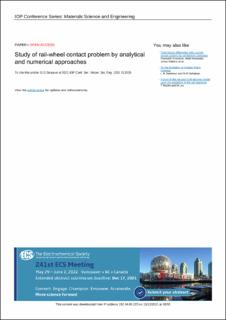| dc.contributor.author | Sirata, Goftila | |
| dc.contributor.author | Lemu, Hirpa G. | |
| dc.contributor.author | Waclawiak, Krzysztof | |
| dc.contributor.author | Jelila, Yohanis D. | |
| dc.date.accessioned | 2021-12-22T12:09:48Z | |
| dc.date.available | 2021-12-22T12:09:48Z | |
| dc.date.created | 2021-12-12T14:46:39Z | |
| dc.date.issued | 2021 | |
| dc.identifier.citation | Sirata, G.G., Lemu, H.G., Waclawiak, K., Jelila, Y.D. (2021) Study of rail-wheel contact problem by analytical and numerical approaches. IOP Conference Series: Materials Science and Engineering, 1201, 012035 | en_US |
| dc.identifier.issn | 1757-8981 | |
| dc.identifier.uri | https://hdl.handle.net/11250/2835384 | |
| dc.description.abstract | This study presents the rail wheel contact problems under normal and tangential categories. Both analytical and numerical approaches were used for modelling, where the analytical approach assumed elliptical contact patches based on the Hertz theory. In the numerical approach, 3D finite element models were used to investigate non-elliptical contact patches. The only elastic material model was considered in the case of Hertz theory. However, in the case of finite element analysis, both elastic and elastoplastic material models were used to simulate the material's behavior under the applied load. The elastoplastic material model was used to determine the amount of stress at which the plastic deformation starts, which enables determining the rail wheel's critical load. The commercial software ABAQUS was employed for 3D modeling and contact stress analysis. The study shows maximum stress at 3 mm from the rail wheel contact surface when the maximum load of 85 kN is applied. This initiates the cracks in the subsurface and causes the portion of the rail wheel to break off in the form of spalling after a certain time. | en_US |
| dc.language.iso | eng | en_US |
| dc.publisher | IOP Publishing | en_US |
| dc.rights | Navngivelse 4.0 Internasjonal | * |
| dc.rights.uri | http://creativecommons.org/licenses/by/4.0/deed.no | * |
| dc.subject | teknologi | en_US |
| dc.title | Study of rail-wheel contact problem by analytical and numerical approaches | en_US |
| dc.type | Peer reviewed | en_US |
| dc.type | Journal article | en_US |
| dc.description.version | publishedVersion | en_US |
| dc.subject.nsi | VDP::Teknologi: 500 | en_US |
| dc.source.volume | 1201 | en_US |
| dc.source.journal | IOP Conference Series: Materials Science and Engineering | en_US |
| dc.identifier.doi | 10.1088/1757-899X/1201/1/012035 | |
| dc.identifier.cristin | 1967426 | |
| dc.source.articlenumber | 012035 | en_US |
| cristin.ispublished | true | |
| cristin.fulltext | original | |
| cristin.qualitycode | 1 | |

